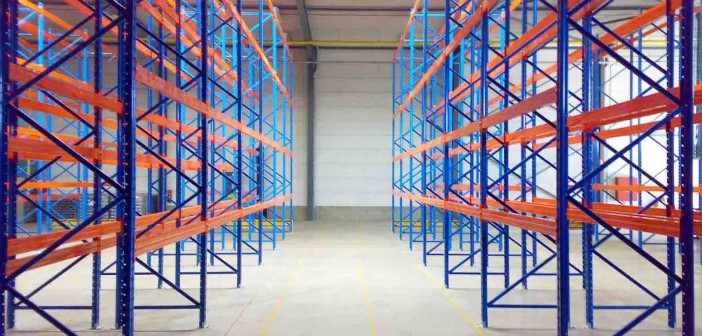Pallet racks (or skids) are large, metal storage devices that consist of vertical supports and horizontal beams. Pallets are stacked on their multiple levels until such time as the palletized materials are needed for out-shipping or store shelf stocking. The main types of companies using pallets and pallet racking systems are warehouses, distribution centers, packaging facilities, manufacturing plants, and retail outlets. Any heavy items that need to be stored, whether for a short or long time period, may well be placed on pallets, and then stacked on various kinds of pallet racks. The particular kind of rack that is best depends on the size of a business’ warehouse or storage room as compared with its inventory, on the rate at which items are brought in and out, and on the variation or uniformity among the products stored. Many companies do not value highly enough the exact type of rack or storage system used, thinking only in terms of total warehouse space. But the way the available space is organized and used is just as important. A business, in choosing a storage system, needs to consider their future growth and plans, and also complement the physical system with an adequate inventory tracking and locating system.
For companies that house a wide variety of products of varying sizes and need to have all their stock constantly accessible since it is subject to quick turnover patterns, a great choice would be the roll formed selective pallet rack system. The arms clip into tear-shaped holes on the uprights and can be very quickly and easily removed and re-positioned to adjust to the frequent rearrangements of fast-paced storage facilities that are depleted and refilled in short time periods. This “big box” system is often appropriate for retail stores, wholesale stores, and cold storage companies. Very narrow aisle selective pallet rack systems are the same but with a more tightly fit arrangement of racks to save extra space.
For companies, such as factories, which produce or store extremely heavy products, structural selective pallet racks are a good option. The beams bearing the heavy loads are attached to the supports using bolts. This gives the rack much greater strength. The shelving is still adjustable- the racks can be unbolted and put back together as needed. But this process is not as easy or quick. Load carrying ability, of necessity, takes precedence over quick adjust-ability. A structural rack that is built into the warehouse itself, such that its vertical beams support the roof of the building, is a variation on the structural selective pallet rack known as a rack supported building.
The above mentioned are the most common pallet racks in use today, but other systems exist too. They include drive in and drive through racks which let the fork enter the pallet lanes, and push-back racks which push pallets together into wide racks rather than concentrate on stacking high. These systems are highly concerned with the order of first in first out or first in last out as to the pallets, and may work well for companies that store large quantities of identical or very similar inventory.
Other innovations to consider are pallet flow lanes that send pallets along a sort of conveyor belt and mobilized pallet racks that only open up forklift lanes when they are needed and thus can cut down needed storage space by 50%. According to Material Handling Exchange Inc., “The rollers are called carriages and move on tracks horizontally. In a warehouse where only a few forks can operated at a time anyway, this may be a good choice.” Money is spent for extra racks per building, but less buildings will be needed. Each business person needs to assess his or her particular situation to determine if rolling racks are right for him or her.
Since the second world war, pallet racks and forklifts have been the dominant sight at warehouses, factories, retail storage areas, and product distribution points. A number of different pallet rack systems exist which lend themselves to use in particular industries or business situations. A good manager must weigh the factors involved and make an informed decision.




